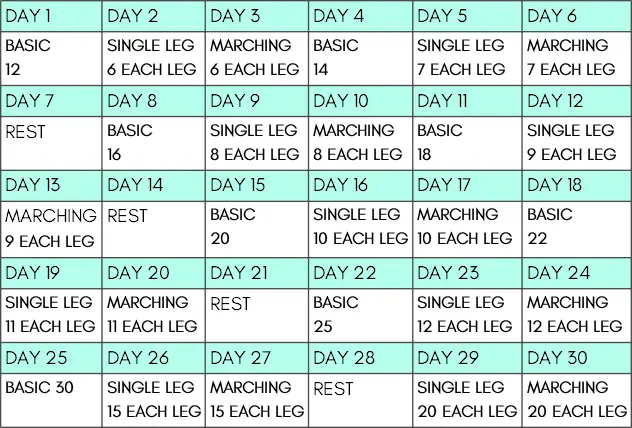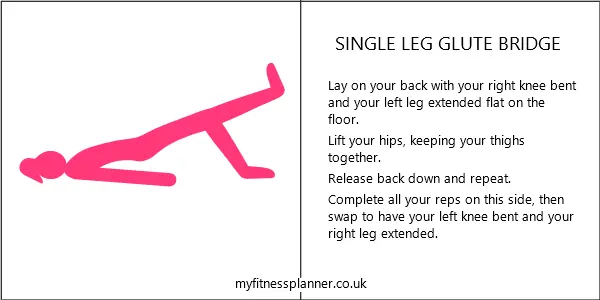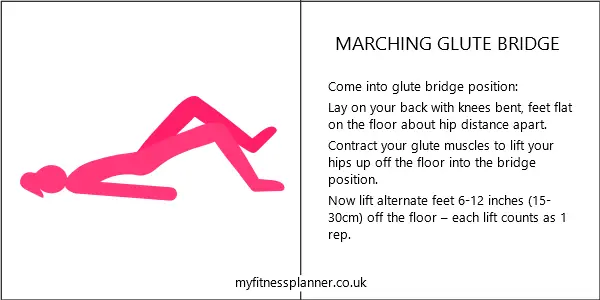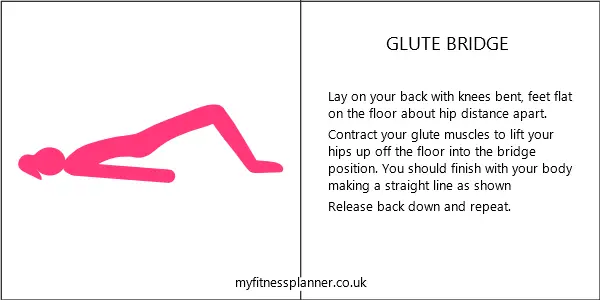The glute bridge focuses on the main gluteal muscle, the gluteus maximus, as well as working the hamstrings and core muscles. This glute bridge challenge includes the basic glute bridge plus two variations, which will increase the challenge for your glutes, as well as adding some work for the muscles at the front of your thighs and the oblique abs.
Glute bridge challenge chart
There are 3 types of glute bridge in the challenge – basic, single leg and marching. The chart gives tells you which to do each day and how many repetitions and instructions for the exercises are below the chart.
Before you do this workout, please read these general exercise guidelines.
You’ll need an exercise mat or some other form of cushioning to do the exercises on – see an exercise mat buying guide here.

Exercise instructions


Role of the core muscles in the glute bridge
The core muscles stabilise the spine and pelvis. Having a strong core has many benefits, including back health and good abdominal tone. In the basic glute bridge, the core muscles assist the glutes in keeping the spine and pelvis in alignment. In the one leg and marching bridges, the oblique abdominal muscles also work to keep the pelvis lifted on the unsupported side.
Problems caused by weak glutes
The gluteus maximus, located at the back of the buttocks is responsible for extending the hips, rotating them externally, and stabilizing the pelvis. The gluteus medius and gluteus minimus, smaller muscles located on the sides of the buttocks, assist in these functions and contribute to hip abduction and stabilization. When these muscles become weak, they can lead to various problems.
Pain and Dysfunction
Weak glutes can contribute to musculoskeletal issues including:
Lower back pain: The glutes play a vital role in stabilizing the lower back. When they are weak, other muscles, such as the lower back muscles, have to compensate, leading to strain and pain.
Hip pain: Weak glutes can alter your gait and hip mechanics, increasing the risk of hip pain and impingement.
Knee pain: Improper hip mechanics due to weak glutes can also put undue stress on the knees, leading to pain and potential injuries.
Iliotibial band (IT) band syndrome: Weak glutes can contribute to IT band tightness and pain, which can cause discomfort and limit mobility.
Weak glutes can also affect athletic performance in various ways:
Diminished power: Glutes are essential for generating power during explosive movements like sprinting, jumping, and changing directions. Weak glutes can limit your power output, affecting your performance in sports and fitness activities.
Decreased stability: Weak glutes can compromise your stability during exercises and activities, making you more prone to falls and injuries.
Reduced endurance: Glutes play a significant role in maintaining proper posture and form during exercise. Weak glutes can lead to poor posture and fatigue, affecting your endurance.
Related to glute bridge challenge
Further reading
Loughborough University gluteus maximum role in sprinting
Challenge FAQs
The first day of the challenge should feel like it needs a bit of effort, but not too much. If you really struggle with day 1, then you probably won’t get through the challenge. The idea with the challenges on this site is that the first few days get you used to the exercises and the daily habit. Usually about halfway through the challenge the effort levels start to increase more quickly.
Avoid challenges that increase effort levels very quickly – they’re simply not realistic. It’s unlikely that, for example, you would be able to increase how many squats you are able to do by 10 a day for 30 days, or increase your plank hold time by 10 seconds a day for 30 days.
Last Updated on: April 24, 2022In general, allowing muscles 48 hours between workouts is good because it gives our bodies time to recover and adapt. Challenges are generally short workouts and for a limited period of time (usually 30 days), so not having many rest days won’t be a problem. With challenges that alternate exercises each day, it’s not an issue, because you’re using different muscles.
Last Updated on: April 24, 2022Fitness improvements don’t always happen in a predictable way. Sometimes we’re just not as strong or energetic for no apparent reason, or we hit a plateau. If you get to a point where you’re struggling to complete the day’s challenge, you can try one of the following:
- Take a couple of days off and start again where you left off
- Do the challenge on alternate days rather than every day
- Instead of increasing the effort every day, stay at the same level for 2 or 3 days and then go onto the next day of the challenge
Obviously these solutions mean the challenge will last longer, but you’ll still benefit from doing it.
Last Updated on: April 24, 2022

